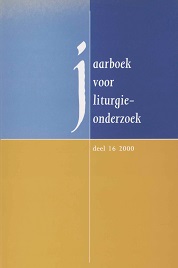Twee protestantse drieluiken
Abstract
Two protestant triptychs. After the Reformation many protestant churches were furnished with large panels with biblical texts, more than 200 of which have survived. The churches of Bourtange in Groningen and Poortugaal in Zuid-Holland possess such panels in the form of triptychs with a well-planned composition of texts. The 1611 Bourtange triptych depicts the Ten Commandments on the central panel, with the Lord’s Prayer below. The left wing contains the Creed, followed by the commission for conversion of the nations (Matt. 28; 18ff). The right wing contains the opening words from the Last Supper (1 Cor. 11:23-26). The 1687 Poortugaal triptych also contains the Ten Commandments on the central panel, followed by some texts about the relationship between Law and Gospel. The left panel contains the Creed followed by the commission from Matthew 28 to convert and baptise all nations. The right panel contains the Lord’s Prayer on the top half, and the opening words of the Last Supper from 1 Cor. 11. These triptychs are valuable because the original text composition has been preserved, both in selection and in their mutual relationships. In Bourtange as well as in Poortugaal this concerns the well-known combination of Creed, Ten Commandments and the Lord’s Prayer, or faith, commandment and prayer, supplemented by the opening words of the Last Supper and some other biblical texts. Both triptychs give pride of place to the Ten Commandments by placing them centrally, with the Poortugaal triptych explaining the meaning of the Law to the believer through some New Testament texts. This concerns the tension between law and gospel: the believer is invited to obey the law, and the law leads to Christ, but in the end it is man’s faith in the mercy of Christ that justifies man, and not his obeying the law. The relationship between sin and mercy, in other words between law and gospel, was a question that seriously preoccupied the Calvinists (Dutch Reformed Church) during the 17th and 18th centuries. An important support to the faithful can be formed by the words of the Creed and the Lord’s Prayer, which is why the Creed and the Our Father are the texts which are most often encountered on these panels after the Ten Commandments. In some churches the panels with the Ten Commandments, Creed and Our Father are placed near the entry to the Choir, where Communion was often celebrated, and the Communion service contains the Creed and the Lord’s Prayer. It is therefore understandable that the triptychs also contain the opening words of the Last Supper from 1 Cor. 11. As far as the form of the triptych is concerned, the Bourtange triptych was probably influenced by Lutheran churches in Ostfriesland. Who bears responsibility for the choice of this unusual form of the text panel in Poortugaal has so far not been discovered.


